Business Transactions and Financial Ratio Analysis Report
VerifiedAdded on 2023/01/03
|15
|2122
|32
Report
AI Summary
This report provides a comprehensive financial analysis of Linda's business, beginning with the recording of business transactions through journal entries, the creation of ledger accounts, and the extraction of a trial balance. The report then details the preparation of an income statement and balance sheet, presenting a clear view of the company's financial position. Furthermore, it delves into financial ratio analysis, calculating and interpreting key ratios to assess the company's performance, liquidity, and efficiency, comparing it to competitors. The report also includes a letter to Linda explaining the accounting treatment of personal drawings. The conclusion summarizes the findings, emphasizing the importance of financial reporting and analysis for informed decision-making.
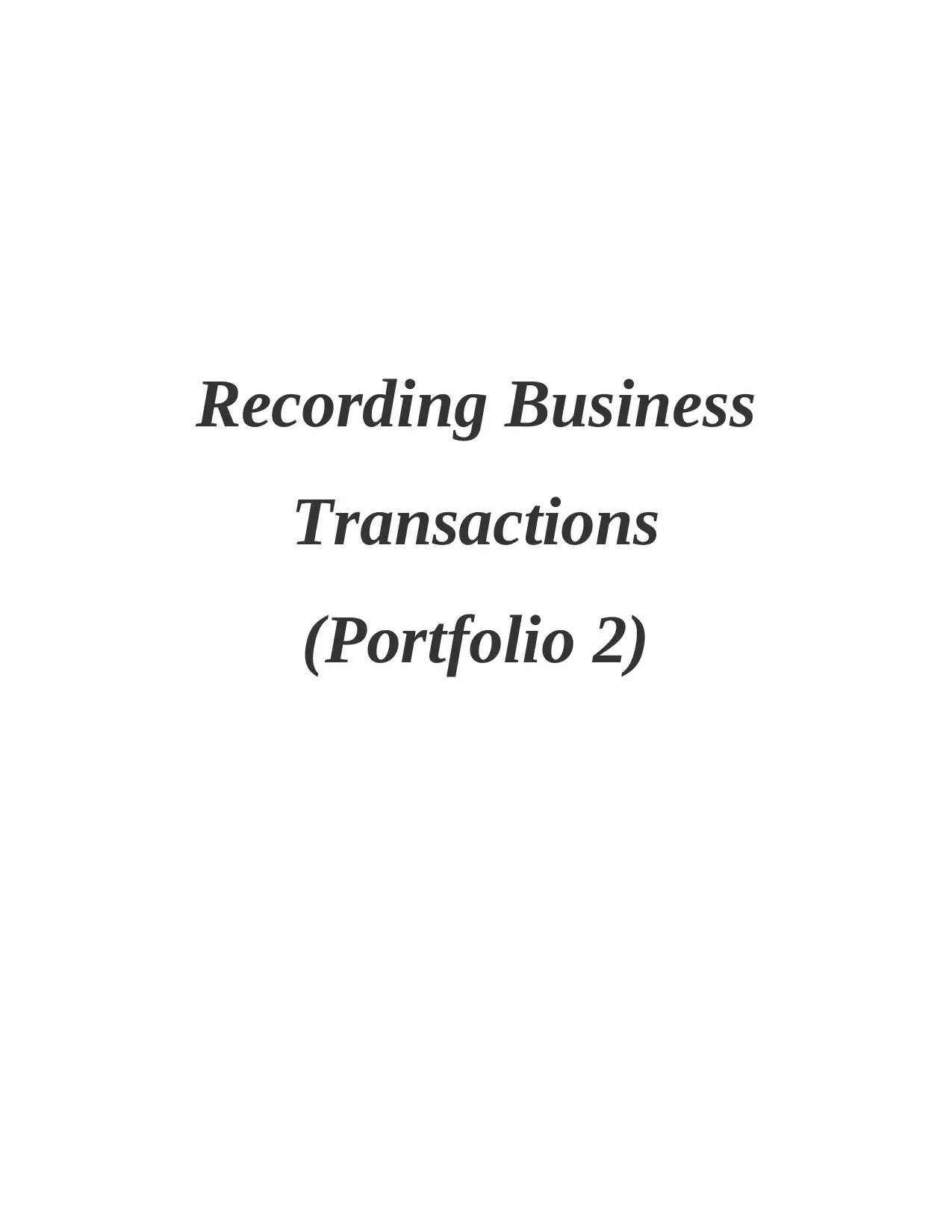
Recording Business
Transactions
(Portfolio 2)
Transactions
(Portfolio 2)
Paraphrase This Document
Need a fresh take? Get an instant paraphrase of this document with our AI Paraphraser
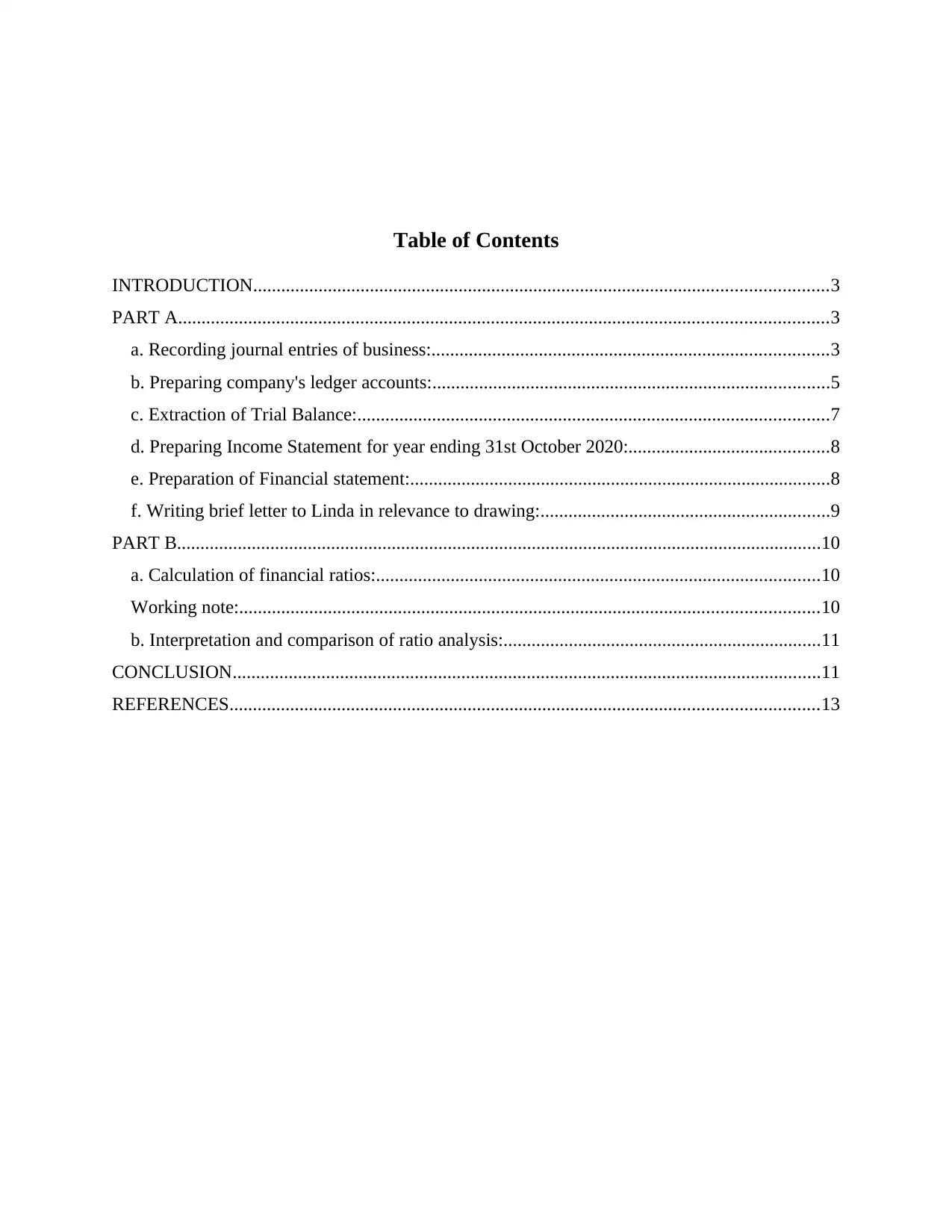
Table of Contents
INTRODUCTION...........................................................................................................................3
PART A...........................................................................................................................................3
a. Recording journal entries of business:.....................................................................................3
b. Preparing company's ledger accounts:.....................................................................................5
c. Extraction of Trial Balance:.....................................................................................................7
d. Preparing Income Statement for year ending 31st October 2020:...........................................8
e. Preparation of Financial statement:..........................................................................................8
f. Writing brief letter to Linda in relevance to drawing:..............................................................9
PART B..........................................................................................................................................10
a. Calculation of financial ratios:...............................................................................................10
Working note:............................................................................................................................10
b. Interpretation and comparison of ratio analysis:....................................................................11
CONCLUSION..............................................................................................................................11
REFERENCES..............................................................................................................................13
INTRODUCTION...........................................................................................................................3
PART A...........................................................................................................................................3
a. Recording journal entries of business:.....................................................................................3
b. Preparing company's ledger accounts:.....................................................................................5
c. Extraction of Trial Balance:.....................................................................................................7
d. Preparing Income Statement for year ending 31st October 2020:...........................................8
e. Preparation of Financial statement:..........................................................................................8
f. Writing brief letter to Linda in relevance to drawing:..............................................................9
PART B..........................................................................................................................................10
a. Calculation of financial ratios:...............................................................................................10
Working note:............................................................................................................................10
b. Interpretation and comparison of ratio analysis:....................................................................11
CONCLUSION..............................................................................................................................11
REFERENCES..............................................................................................................................13
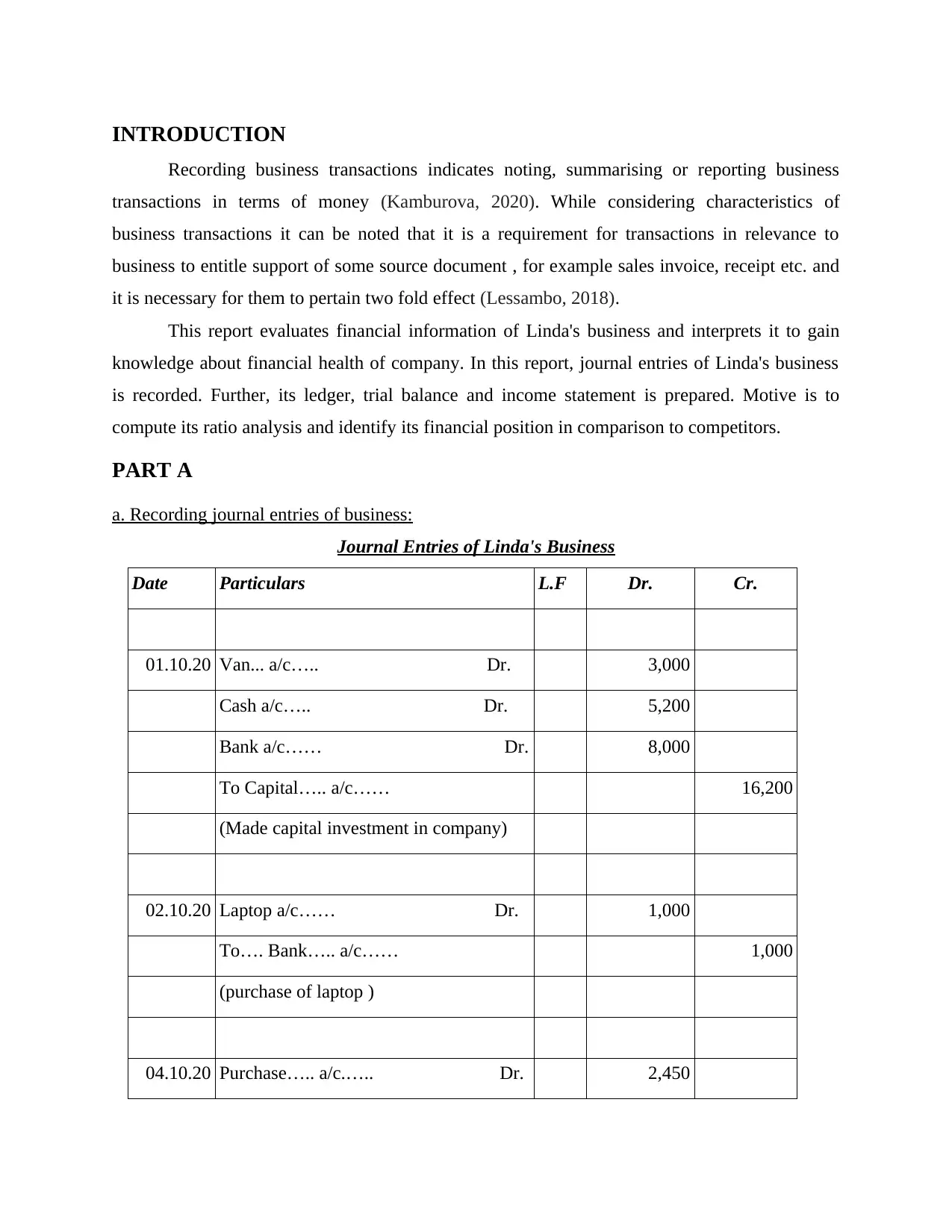
INTRODUCTION
Recording business transactions indicates noting, summarising or reporting business
transactions in terms of money (Kamburova, 2020). While considering characteristics of
business transactions it can be noted that it is a requirement for transactions in relevance to
business to entitle support of some source document , for example sales invoice, receipt etc. and
it is necessary for them to pertain two fold effect (Lessambo, 2018).
This report evaluates financial information of Linda's business and interprets it to gain
knowledge about financial health of company. In this report, journal entries of Linda's business
is recorded. Further, its ledger, trial balance and income statement is prepared. Motive is to
compute its ratio analysis and identify its financial position in comparison to competitors.
PART A
a. Recording journal entries of business:
Journal Entries of Linda's Business
Date Particulars L.F Dr. Cr.
01.10.20 Van... a/c….. Dr. 3,000
Cash a/c….. Dr. 5,200
Bank a/c…… Dr. 8,000
To Capital….. a/c…… 16,200
(Made capital investment in company)
02.10.20 Laptop a/c…… Dr. 1,000
To…. Bank….. a/c…… 1,000
(purchase of laptop )
04.10.20 Purchase….. a/c.….. Dr. 2,450
Recording business transactions indicates noting, summarising or reporting business
transactions in terms of money (Kamburova, 2020). While considering characteristics of
business transactions it can be noted that it is a requirement for transactions in relevance to
business to entitle support of some source document , for example sales invoice, receipt etc. and
it is necessary for them to pertain two fold effect (Lessambo, 2018).
This report evaluates financial information of Linda's business and interprets it to gain
knowledge about financial health of company. In this report, journal entries of Linda's business
is recorded. Further, its ledger, trial balance and income statement is prepared. Motive is to
compute its ratio analysis and identify its financial position in comparison to competitors.
PART A
a. Recording journal entries of business:
Journal Entries of Linda's Business
Date Particulars L.F Dr. Cr.
01.10.20 Van... a/c….. Dr. 3,000
Cash a/c….. Dr. 5,200
Bank a/c…… Dr. 8,000
To Capital….. a/c…… 16,200
(Made capital investment in company)
02.10.20 Laptop a/c…… Dr. 1,000
To…. Bank….. a/c…… 1,000
(purchase of laptop )
04.10.20 Purchase….. a/c.….. Dr. 2,450
⊘ This is a preview!⊘
Do you want full access?
Subscribe today to unlock all pages.

Trusted by 1+ million students worldwide
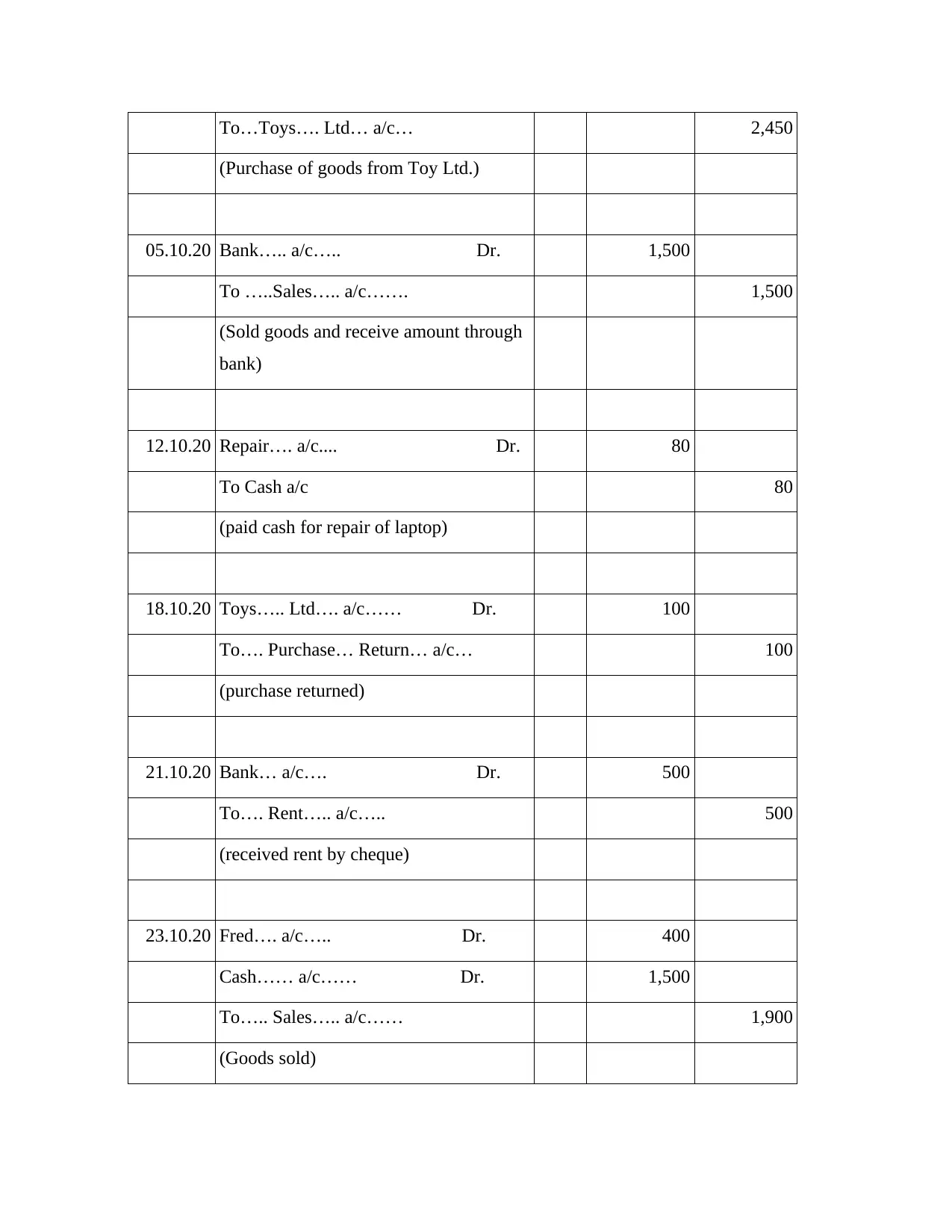
To…Toys…. Ltd… a/c… 2,450
(Purchase of goods from Toy Ltd.)
05.10.20 Bank….. a/c….. Dr. 1,500
To …..Sales….. a/c……. 1,500
(Sold goods and receive amount through
bank)
12.10.20 Repair…. a/c.... Dr. 80
To Cash a/c 80
(paid cash for repair of laptop)
18.10.20 Toys….. Ltd…. a/c…… Dr. 100
To…. Purchase… Return… a/c… 100
(purchase returned)
21.10.20 Bank… a/c…. Dr. 500
To…. Rent….. a/c….. 500
(received rent by cheque)
23.10.20 Fred…. a/c….. Dr. 400
Cash…… a/c…… Dr. 1,500
To….. Sales….. a/c…… 1,900
(Goods sold)
(Purchase of goods from Toy Ltd.)
05.10.20 Bank….. a/c….. Dr. 1,500
To …..Sales….. a/c……. 1,500
(Sold goods and receive amount through
bank)
12.10.20 Repair…. a/c.... Dr. 80
To Cash a/c 80
(paid cash for repair of laptop)
18.10.20 Toys….. Ltd…. a/c…… Dr. 100
To…. Purchase… Return… a/c… 100
(purchase returned)
21.10.20 Bank… a/c…. Dr. 500
To…. Rent….. a/c….. 500
(received rent by cheque)
23.10.20 Fred…. a/c….. Dr. 400
Cash…… a/c…… Dr. 1,500
To….. Sales….. a/c…… 1,900
(Goods sold)
Paraphrase This Document
Need a fresh take? Get an instant paraphrase of this document with our AI Paraphraser
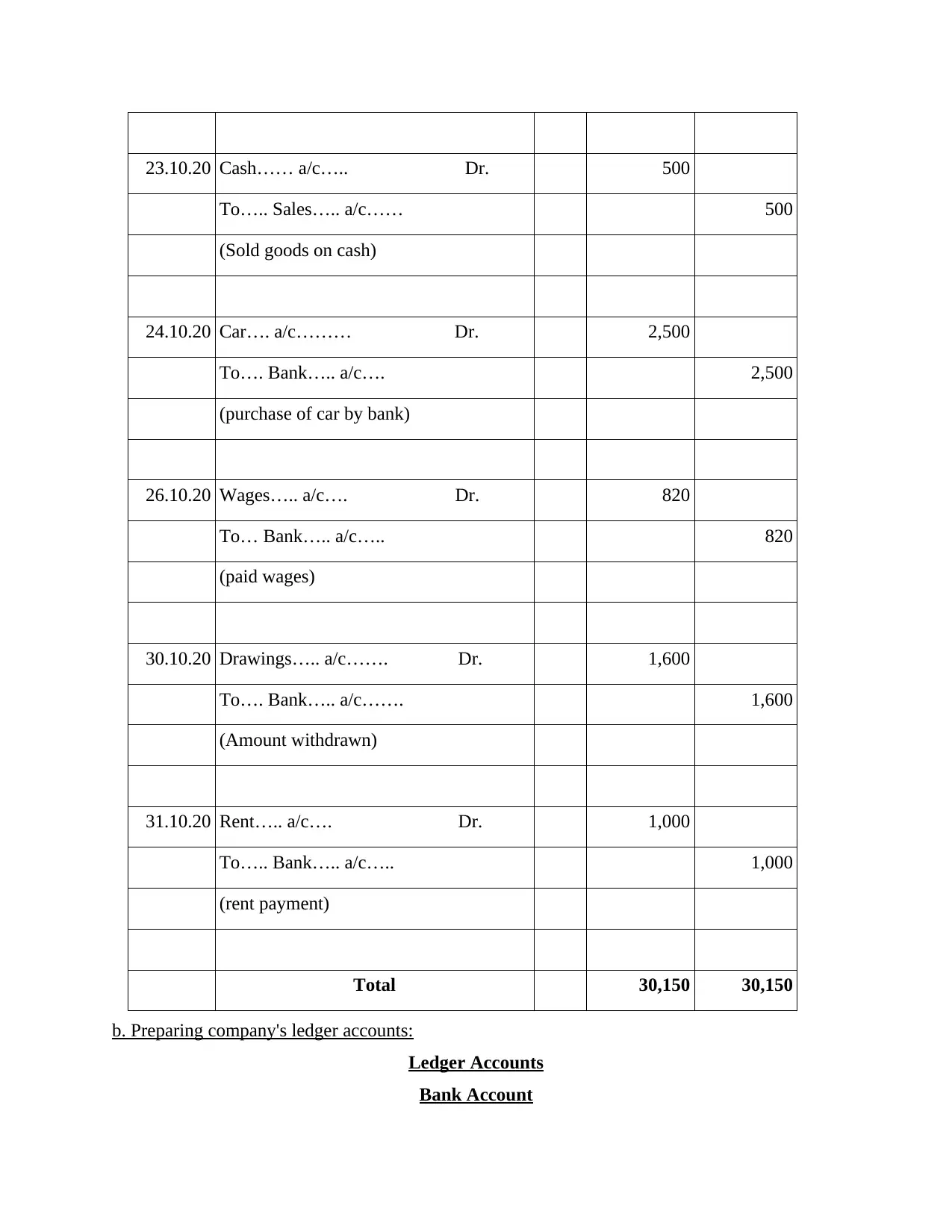
23.10.20 Cash…… a/c….. Dr. 500
To….. Sales….. a/c…… 500
(Sold goods on cash)
24.10.20 Car…. a/c……… Dr. 2,500
To…. Bank….. a/c…. 2,500
(purchase of car by bank)
26.10.20 Wages….. a/c…. Dr. 820
To… Bank….. a/c….. 820
(paid wages)
30.10.20 Drawings….. a/c……. Dr. 1,600
To…. Bank….. a/c……. 1,600
(Amount withdrawn)
31.10.20 Rent….. a/c…. Dr. 1,000
To….. Bank….. a/c….. 1,000
(rent payment)
Total 30,150 30,150
b. Preparing company's ledger accounts:
Ledger Accounts
Bank Account
To….. Sales….. a/c…… 500
(Sold goods on cash)
24.10.20 Car…. a/c……… Dr. 2,500
To…. Bank….. a/c…. 2,500
(purchase of car by bank)
26.10.20 Wages….. a/c…. Dr. 820
To… Bank….. a/c….. 820
(paid wages)
30.10.20 Drawings….. a/c……. Dr. 1,600
To…. Bank….. a/c……. 1,600
(Amount withdrawn)
31.10.20 Rent….. a/c…. Dr. 1,000
To….. Bank….. a/c….. 1,000
(rent payment)
Total 30,150 30,150
b. Preparing company's ledger accounts:
Ledger Accounts
Bank Account
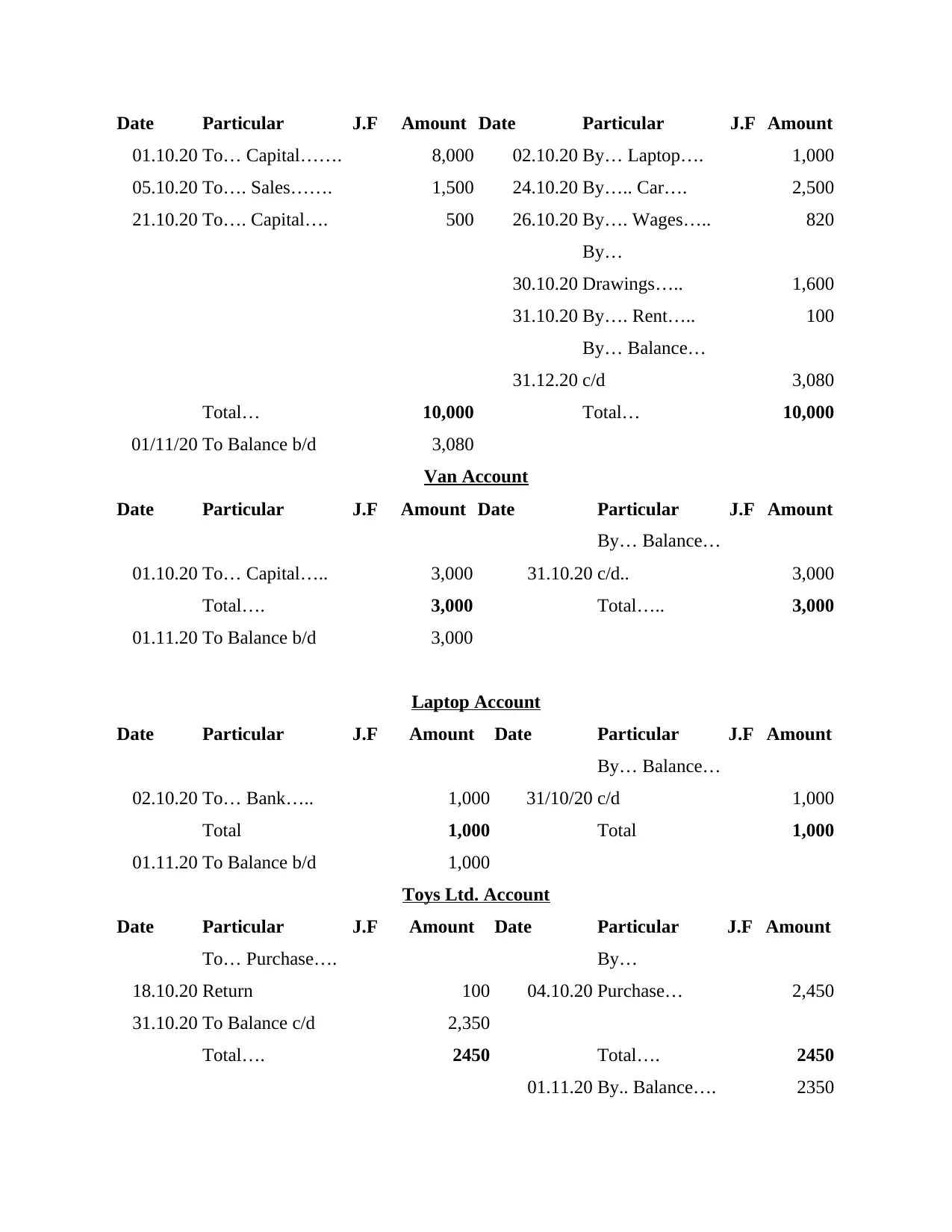
Date Particular J.F Amount Date Particular J.F Amount
01.10.20 To… Capital……. 8,000 02.10.20 By… Laptop…. 1,000
05.10.20 To…. Sales……. 1,500 24.10.20 By….. Car…. 2,500
21.10.20 To…. Capital…. 500 26.10.20 By…. Wages….. 820
30.10.20
By…
Drawings….. 1,600
31.10.20 By…. Rent….. 100
31.12.20
By… Balance…
c/d 3,080
Total… 10,000 Total… 10,000
01/11/20 To Balance b/d 3,080
Van Account
Date Particular J.F Amount Date Particular J.F Amount
01.10.20 To… Capital….. 3,000 31.10.20
By… Balance…
c/d.. 3,000
Total…. 3,000 Total….. 3,000
01.11.20 To Balance b/d 3,000
Laptop Account
Date Particular J.F Amount Date Particular J.F Amount
02.10.20 To… Bank….. 1,000 31/10/20
By… Balance…
c/d 1,000
Total 1,000 Total 1,000
01.11.20 To Balance b/d 1,000
Toys Ltd. Account
Date Particular J.F Amount Date Particular J.F Amount
18.10.20
To… Purchase….
Return 100 04.10.20
By…
Purchase… 2,450
31.10.20 To Balance c/d 2,350
Total…. 2450 Total…. 2450
01.11.20 By.. Balance…. 2350
01.10.20 To… Capital……. 8,000 02.10.20 By… Laptop…. 1,000
05.10.20 To…. Sales……. 1,500 24.10.20 By….. Car…. 2,500
21.10.20 To…. Capital…. 500 26.10.20 By…. Wages….. 820
30.10.20
By…
Drawings….. 1,600
31.10.20 By…. Rent….. 100
31.12.20
By… Balance…
c/d 3,080
Total… 10,000 Total… 10,000
01/11/20 To Balance b/d 3,080
Van Account
Date Particular J.F Amount Date Particular J.F Amount
01.10.20 To… Capital….. 3,000 31.10.20
By… Balance…
c/d.. 3,000
Total…. 3,000 Total….. 3,000
01.11.20 To Balance b/d 3,000
Laptop Account
Date Particular J.F Amount Date Particular J.F Amount
02.10.20 To… Bank….. 1,000 31/10/20
By… Balance…
c/d 1,000
Total 1,000 Total 1,000
01.11.20 To Balance b/d 1,000
Toys Ltd. Account
Date Particular J.F Amount Date Particular J.F Amount
18.10.20
To… Purchase….
Return 100 04.10.20
By…
Purchase… 2,450
31.10.20 To Balance c/d 2,350
Total…. 2450 Total…. 2450
01.11.20 By.. Balance…. 2350
⊘ This is a preview!⊘
Do you want full access?
Subscribe today to unlock all pages.

Trusted by 1+ million students worldwide
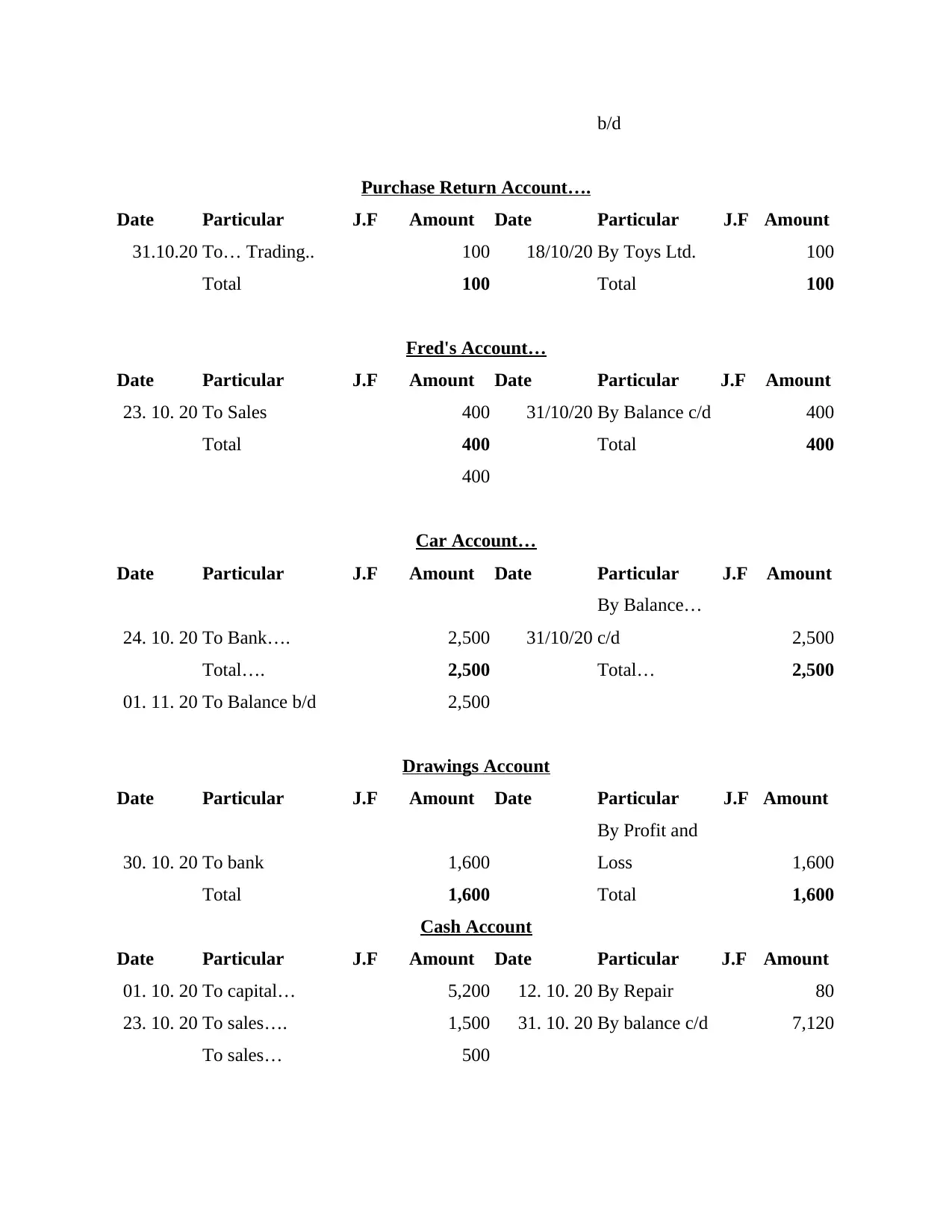
b/d
Purchase Return Account….
Date Particular J.F Amount Date Particular J.F Amount
31.10.20 To… Trading.. 100 18/10/20 By Toys Ltd. 100
Total 100 Total 100
Fred's Account…
Date Particular J.F Amount Date Particular J.F Amount
23. 10. 20 To Sales 400 31/10/20 By Balance c/d 400
Total 400 Total 400
400
Car Account…
Date Particular J.F Amount Date Particular J.F Amount
24. 10. 20 To Bank…. 2,500 31/10/20
By Balance…
c/d 2,500
Total…. 2,500 Total… 2,500
01. 11. 20 To Balance b/d 2,500
Drawings Account
Date Particular J.F Amount Date Particular J.F Amount
30. 10. 20 To bank 1,600
By Profit and
Loss 1,600
Total 1,600 Total 1,600
Cash Account
Date Particular J.F Amount Date Particular J.F Amount
01. 10. 20 To capital… 5,200 12. 10. 20 By Repair 80
23. 10. 20 To sales…. 1,500 31. 10. 20 By balance c/d 7,120
To sales… 500
Purchase Return Account….
Date Particular J.F Amount Date Particular J.F Amount
31.10.20 To… Trading.. 100 18/10/20 By Toys Ltd. 100
Total 100 Total 100
Fred's Account…
Date Particular J.F Amount Date Particular J.F Amount
23. 10. 20 To Sales 400 31/10/20 By Balance c/d 400
Total 400 Total 400
400
Car Account…
Date Particular J.F Amount Date Particular J.F Amount
24. 10. 20 To Bank…. 2,500 31/10/20
By Balance…
c/d 2,500
Total…. 2,500 Total… 2,500
01. 11. 20 To Balance b/d 2,500
Drawings Account
Date Particular J.F Amount Date Particular J.F Amount
30. 10. 20 To bank 1,600
By Profit and
Loss 1,600
Total 1,600 Total 1,600
Cash Account
Date Particular J.F Amount Date Particular J.F Amount
01. 10. 20 To capital… 5,200 12. 10. 20 By Repair 80
23. 10. 20 To sales…. 1,500 31. 10. 20 By balance c/d 7,120
To sales… 500
Paraphrase This Document
Need a fresh take? Get an instant paraphrase of this document with our AI Paraphraser
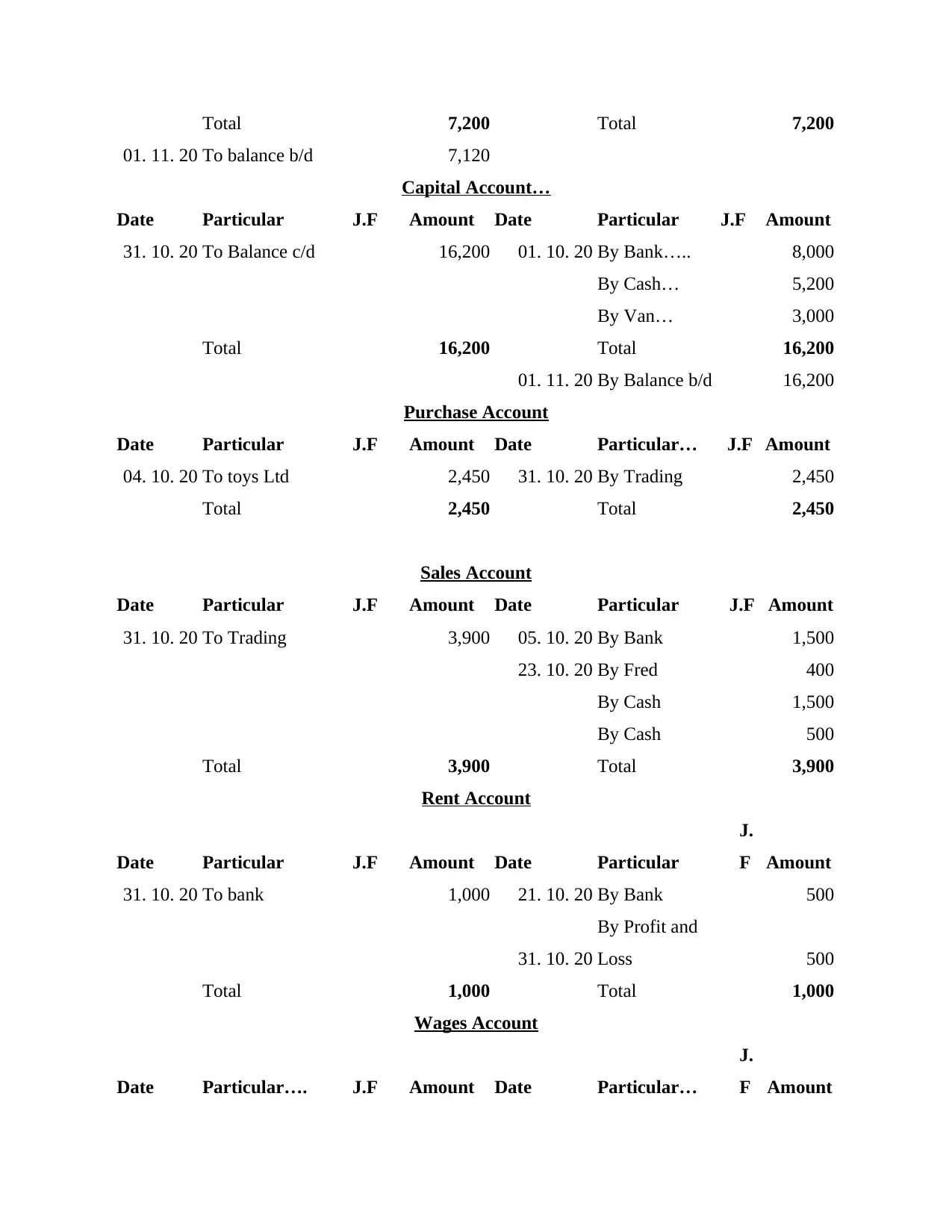
Total 7,200 Total 7,200
01. 11. 20 To balance b/d 7,120
Capital Account…
Date Particular J.F Amount Date Particular J.F Amount
31. 10. 20 To Balance c/d 16,200 01. 10. 20 By Bank….. 8,000
By Cash… 5,200
By Van… 3,000
Total 16,200 Total 16,200
01. 11. 20 By Balance b/d 16,200
Purchase Account
Date Particular J.F Amount Date Particular… J.F Amount
04. 10. 20 To toys Ltd 2,450 31. 10. 20 By Trading 2,450
Total 2,450 Total 2,450
Sales Account
Date Particular J.F Amount Date Particular J.F Amount
31. 10. 20 To Trading 3,900 05. 10. 20 By Bank 1,500
23. 10. 20 By Fred 400
By Cash 1,500
By Cash 500
Total 3,900 Total 3,900
Rent Account
Date Particular J.F Amount Date Particular
J.
F Amount
31. 10. 20 To bank 1,000 21. 10. 20 By Bank 500
31. 10. 20
By Profit and
Loss 500
Total 1,000 Total 1,000
Wages Account
Date Particular…. J.F Amount Date Particular…
J.
F Amount
01. 11. 20 To balance b/d 7,120
Capital Account…
Date Particular J.F Amount Date Particular J.F Amount
31. 10. 20 To Balance c/d 16,200 01. 10. 20 By Bank….. 8,000
By Cash… 5,200
By Van… 3,000
Total 16,200 Total 16,200
01. 11. 20 By Balance b/d 16,200
Purchase Account
Date Particular J.F Amount Date Particular… J.F Amount
04. 10. 20 To toys Ltd 2,450 31. 10. 20 By Trading 2,450
Total 2,450 Total 2,450
Sales Account
Date Particular J.F Amount Date Particular J.F Amount
31. 10. 20 To Trading 3,900 05. 10. 20 By Bank 1,500
23. 10. 20 By Fred 400
By Cash 1,500
By Cash 500
Total 3,900 Total 3,900
Rent Account
Date Particular J.F Amount Date Particular
J.
F Amount
31. 10. 20 To bank 1,000 21. 10. 20 By Bank 500
31. 10. 20
By Profit and
Loss 500
Total 1,000 Total 1,000
Wages Account
Date Particular…. J.F Amount Date Particular…
J.
F Amount
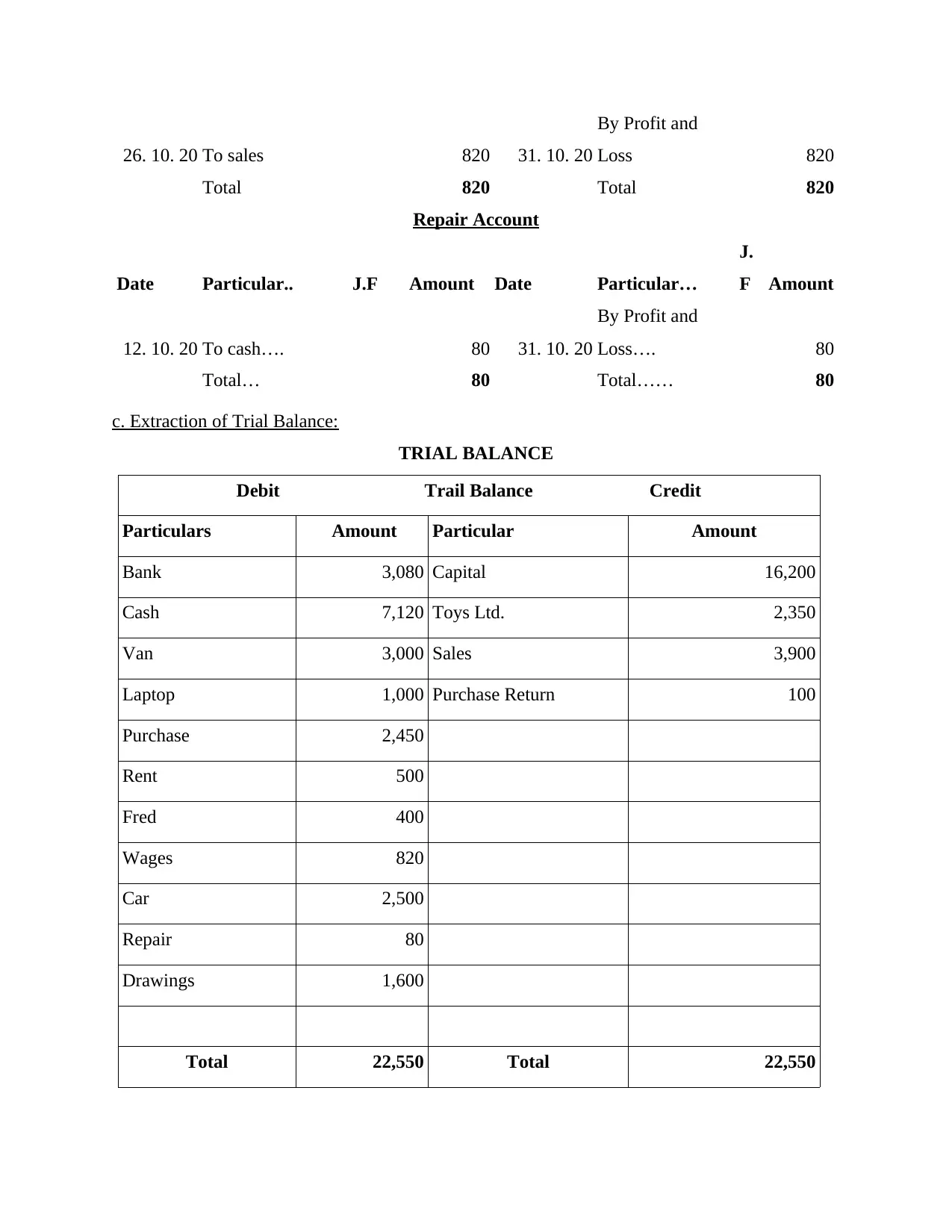
26. 10. 20 To sales 820 31. 10. 20
By Profit and
Loss 820
Total 820 Total 820
Repair Account
Date Particular.. J.F Amount Date Particular…
J.
F Amount
12. 10. 20 To cash…. 80 31. 10. 20
By Profit and
Loss…. 80
Total… 80 Total…… 80
c. Extraction of Trial Balance:
TRIAL BALANCE
Debit Trail Balance Credit
Particulars Amount Particular Amount
Bank 3,080 Capital 16,200
Cash 7,120 Toys Ltd. 2,350
Van 3,000 Sales 3,900
Laptop 1,000 Purchase Return 100
Purchase 2,450
Rent 500
Fred 400
Wages 820
Car 2,500
Repair 80
Drawings 1,600
Total 22,550 Total 22,550
By Profit and
Loss 820
Total 820 Total 820
Repair Account
Date Particular.. J.F Amount Date Particular…
J.
F Amount
12. 10. 20 To cash…. 80 31. 10. 20
By Profit and
Loss…. 80
Total… 80 Total…… 80
c. Extraction of Trial Balance:
TRIAL BALANCE
Debit Trail Balance Credit
Particulars Amount Particular Amount
Bank 3,080 Capital 16,200
Cash 7,120 Toys Ltd. 2,350
Van 3,000 Sales 3,900
Laptop 1,000 Purchase Return 100
Purchase 2,450
Rent 500
Fred 400
Wages 820
Car 2,500
Repair 80
Drawings 1,600
Total 22,550 Total 22,550
⊘ This is a preview!⊘
Do you want full access?
Subscribe today to unlock all pages.

Trusted by 1+ million students worldwide

d. Preparing profit and loss Statement :
e. Preparation of Financial statement:
Balance Sheet
Liabilities Amount Assets Amount
Capital
16,200 Bank 3,080
Less: Drawings 1,600 14600 Cash 7,120
Creditor (Toys Ltd) 2350 Van 3,000
e. Preparation of Financial statement:
Balance Sheet
Liabilities Amount Assets Amount
Capital
16,200 Bank 3,080
Less: Drawings 1,600 14600 Cash 7,120
Creditor (Toys Ltd) 2350 Van 3,000
Paraphrase This Document
Need a fresh take? Get an instant paraphrase of this document with our AI Paraphraser
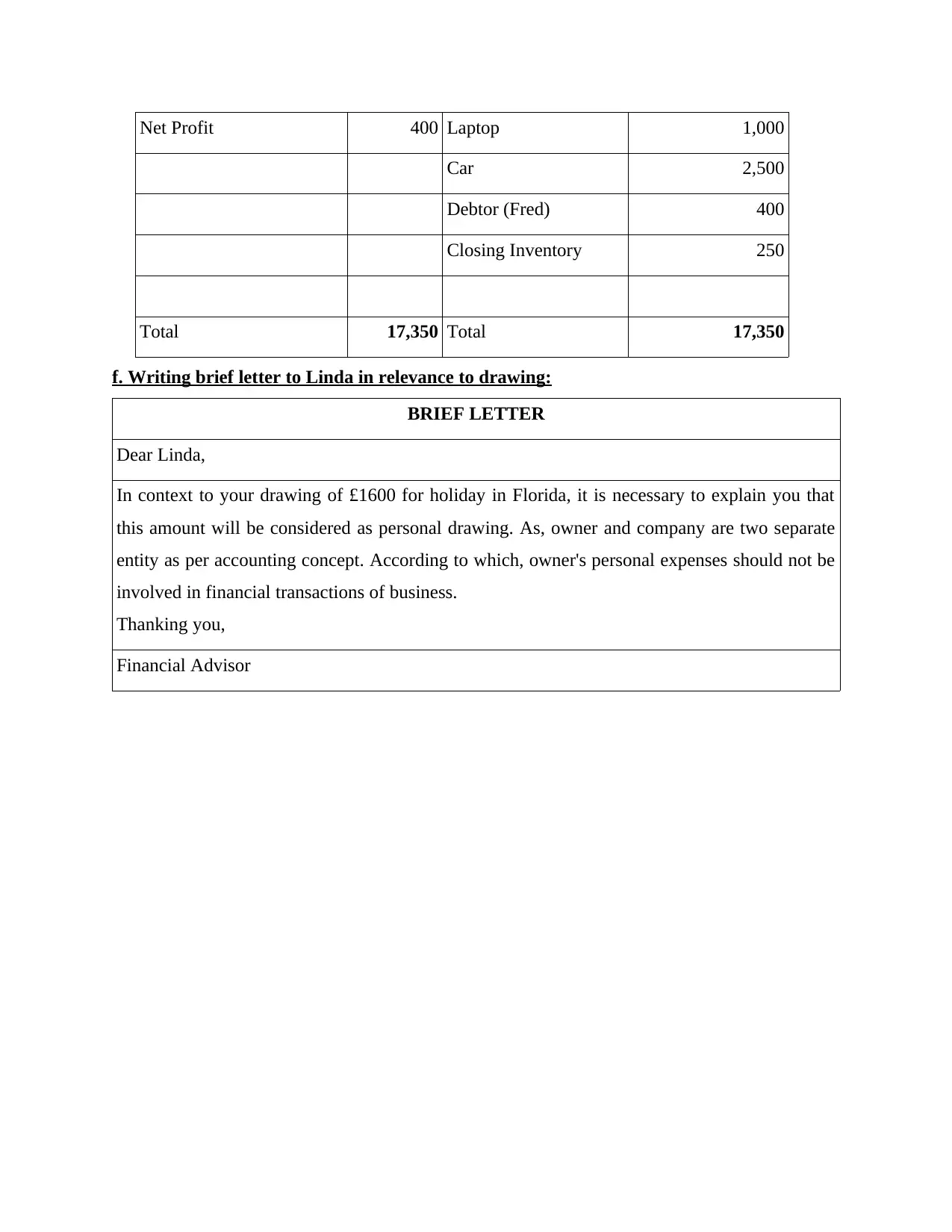
Net Profit 400 Laptop 1,000
Car 2,500
Debtor (Fred) 400
Closing Inventory 250
Total 17,350 Total 17,350
f. Writing brief letter to Linda in relevance to drawing:
BRIEF LETTER
Dear Linda,
In context to your drawing of £1600 for holiday in Florida, it is necessary to explain you that
this amount will be considered as personal drawing. As, owner and company are two separate
entity as per accounting concept. According to which, owner's personal expenses should not be
involved in financial transactions of business.
Thanking you,
Financial Advisor
Car 2,500
Debtor (Fred) 400
Closing Inventory 250
Total 17,350 Total 17,350
f. Writing brief letter to Linda in relevance to drawing:
BRIEF LETTER
Dear Linda,
In context to your drawing of £1600 for holiday in Florida, it is necessary to explain you that
this amount will be considered as personal drawing. As, owner and company are two separate
entity as per accounting concept. According to which, owner's personal expenses should not be
involved in financial transactions of business.
Thanking you,
Financial Advisor
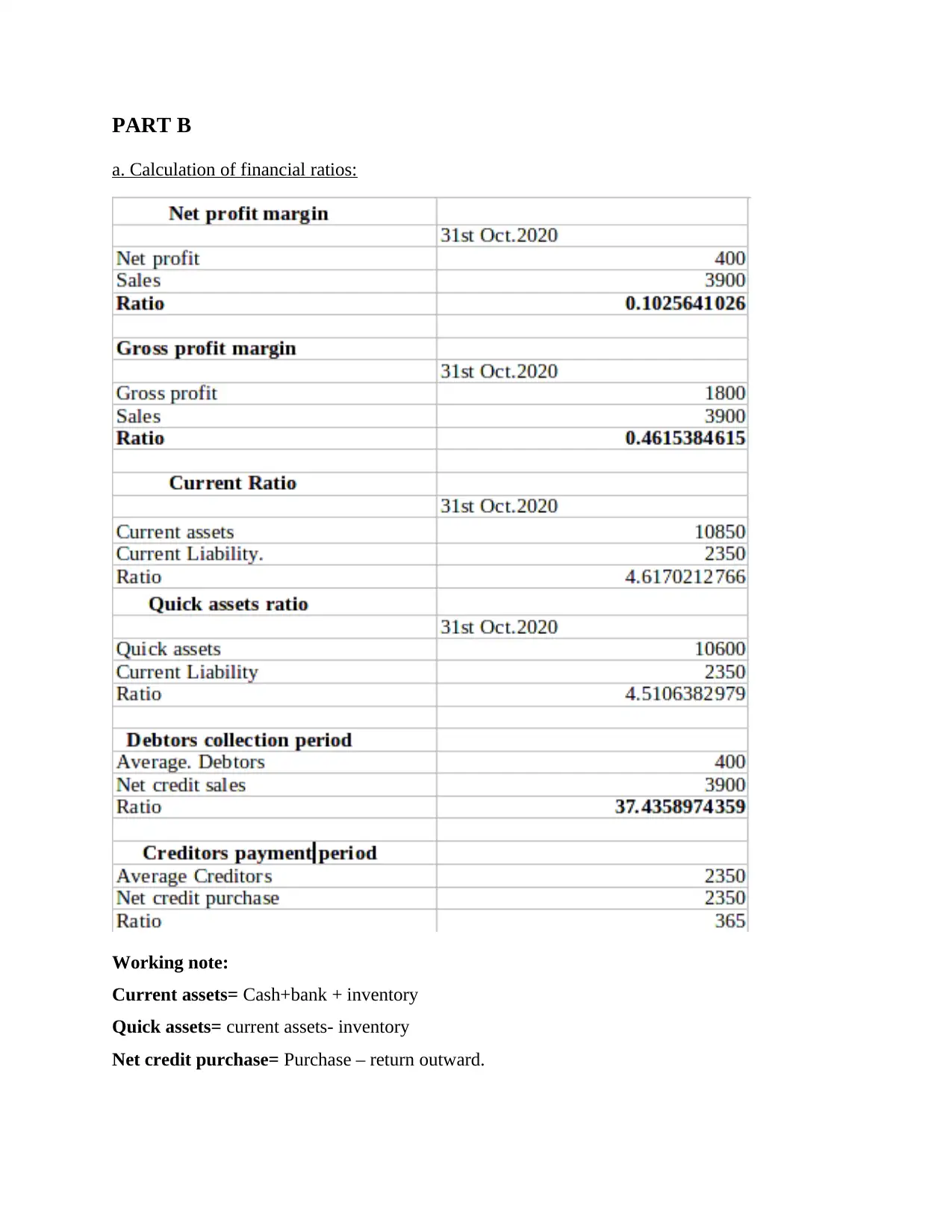
PART B
a. Calculation of financial ratios:
Working note:
Current assets= Cash+bank + inventory
Quick assets= current assets- inventory
Net credit purchase= Purchase – return outward.
a. Calculation of financial ratios:
Working note:
Current assets= Cash+bank + inventory
Quick assets= current assets- inventory
Net credit purchase= Purchase – return outward.
⊘ This is a preview!⊘
Do you want full access?
Subscribe today to unlock all pages.

Trusted by 1+ million students worldwide
1 out of 15
Related Documents
Your All-in-One AI-Powered Toolkit for Academic Success.
+13062052269
info@desklib.com
Available 24*7 on WhatsApp / Email
![[object Object]](/_next/static/media/star-bottom.7253800d.svg)
Unlock your academic potential
Copyright © 2020–2025 A2Z Services. All Rights Reserved. Developed and managed by ZUCOL.





